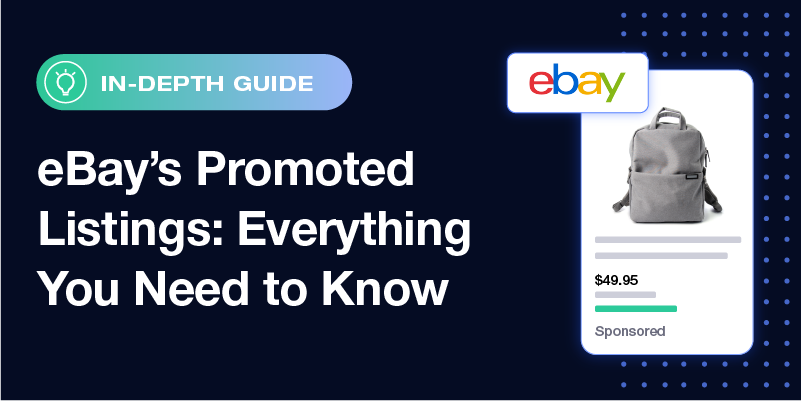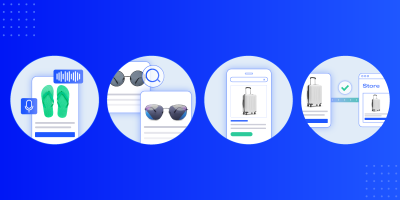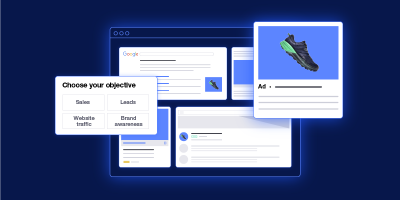eBay is the fourth-largest marketplace in terms of US market share and is ranked number one by sellers in terms of profitability, customer service, communication, and ease of use. But with more than 1.6 billion active listings on the site, how do sellers stand out from the competition?
In 2015, eBay introduced its Promoted Listings program to help ebay store owners give their products an extra boost. The original Ebay Promoted Listings program was revolutionary because it worked on a cost-per-sale basis, allowing sellers to pay a percentage of the sale to the marketplace in exchange for promotion, unlike the traditional cost-per-click (CPC) models. Since then, eBay has added more options to the Promoted Listings program and, in 2022, launched an advanced version (currently in beta) that offers keyword targeting capabilities.
Want to see how you can utilize eBay’s latest Promoted Listings features for your ecommerce business? Continue reading to learn everything you need to know about advertising using our ebay product listing services!
What are Promoted Listings?
In a nutshell, Promoted Listings are product listing ads that appear on and off eBay, including in search results, listing pages, and other placements. There are three types of Promoted Listings campaigns available to eBay sellers. Each one offers insertion fees, a different cost model and placement options for your ads.
These are the three types of Promoted Listings campaigns:
- Promoted Listings Standard
- Promoted Listings Express
- Promoted Listings Advanced
eBay Promoted Listings Standard and Ad Rates Explained
How do eBay’s Promoted Listings Standard campaigns work?
Promoted Listings Standard only charges a seller when a promoted item is sold. While sellers have limited control over the finer points of the ad campaign, like bidding on keywords and targeting, using Promoted Listings Standard still gives your products more exposure to more buyers. Promoted listings are marked with a “Sponsored” listing tag. If a shopper clicks a promoted listing and buys it within 30 days, the sale is attributed to the Standard campaign, and the seller pays an ad fee.
Where and when do Promoted Listings Standard ads appear?
When using a Standard campaign to promote your products, your listings display across the eBay network, including search results, product pages, and eBay’s partner websites. Your listings may also appear in sponsored placements on search engines to help drive active shoppers not currently on the eBay platform to your product listings.
Your listing’s data quality, its relevance to the shopper’s query, and the amount you want to pay to promote it (eBay calls this ad rate) determine where and when your ads display compared to other sellers’ Promoted Listings.
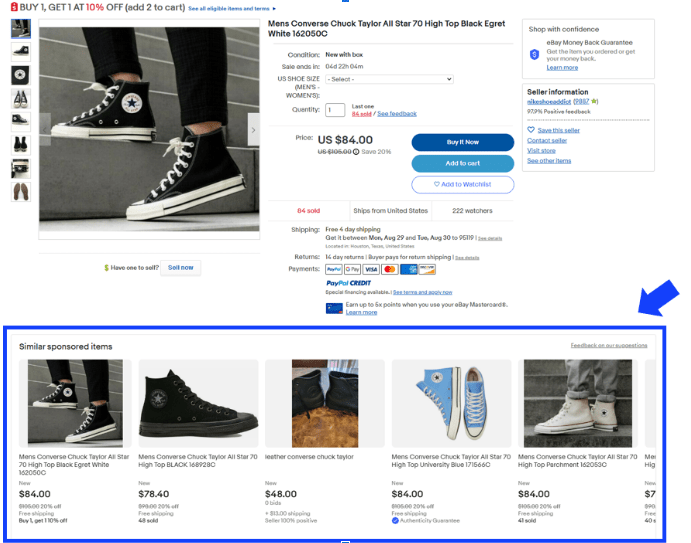
Who is eligible to use Promoted Listings Standard?
Sellers that have enough account activity and an above-standard or top-rated seller level are eligible to use this campaign.
What are the fees for using Promoted Listings Standard?
Standard campaigns allow sellers to decide their ad rate. Sellers can choose an ad rate between 2% and 100% of the item’s total sale amount. The ad rate is calculated as a percentage of the sale price (excluding shipping and taxes). For example, if you sell a $30 fixed price listing product through a standard ad, and your ad rate was 5%, you would pay $1.50 once the item is sold. Setting ad rates as a percentage of sale price allows sellers to calculate their profit margins in advance.
When setting up your listing, eBay provides suggested ad rates based on your item’s attributes, current competition, seasonality, and previous seller performance. Visibility depends on your ad rate. A higher ad rate increases your chances of a higher ad placement, and better ad placement increases the likelihood of a sale.
If an item is returned, canceled, or not paid, the seller receives a Promoted Listings credit that reimburses them for the ad fee on their next invoice.
Promoted Listings Express
How do eBay Promoted Listings Express campaigns work?
Express campaigns promote products you are selling through eBay auctions. Unlike Standard campaigns, sellers pay a flat fee to promote their auction item, regardless of whether it sells. Previously, Express campaigns were only accessible on the eBay app, but now sellers can create and manage their Express listings via desktop. Auctions that utilized Promoted Listings Express saw a 48% increase in listing views.
Where and when do Promoted Listings Express ads appear?
Express campaigns only show your promoted products alongside other related auction-style listings. So rather than appearing in search results, partner websites, or on search engines, Express listings only appear within other sellers’ auction listings of similar products. The Express listing displays below the related product in a section with the headline “Similar sponsored items.”

Who is eligible to use Promoted Listings Express?
To use Promoted Listings Express, sellers must have enough account activity as well as an above-standard or top-rated seller level. In addition, the listings they promote cannot be within the following categories: vehicles, real estate, travel, or other select categories.
What are the fees for using Promoted Listings Express?
The seller pays a single flat fee per item upfront to utilize Promoted Listings Express. The Express ad fee depends on the length of your auction and the selected product category. The fee is generated instantly and is clearly stated prior to your purchase confirmation.
Promoted Listings Advanced
How do eBay’s Promoted Listings Advanced campaigns work?
The Advanced campaign is the newest ad type to join eBay’s Promoted Listings. Advanced campaign ads promote fixed-price listings by providing preferred access to the top of search results. Unlike the previously mentioned ad campaigns, this new program helps sellers target buyers searching for specific keywords and phrases by adopting a CPC model, similar to Google Search campaigns.
Advanced campaigns also allow sellers to create strategic ad groups and organize listings into categories. These groups can be used to target the same set of keywords. For example, if you sell athletic apparel, you can organize all of your shoe listings into one category that targets search terms related to athletic footwear, and place all of your weight-lifting belt listings into another category that targets queries related to gym accessories.
The setup wizard for Promoted Listings Advanced allows the seller to set a daily budget and choose keywords and search terms to bid on. If you have the winning bid for a specific keyword, your listing appears at the top. Each time a shopper clicks on your sponsored listing, you are charged your bid amount. Once your daily budget has been met, your ads stop being served until the next day.
Where do Promoted Listings Advanced ads appear?
Using Advanced campaigns give you the highest visibility, placing your product in one of the top four slots of eBay’s search results on all platforms. Your listing quality, keyword relevance, bid amount, competition’s bid amount, and reserve price are all factors that help eBay determine which listings display in these top slots.
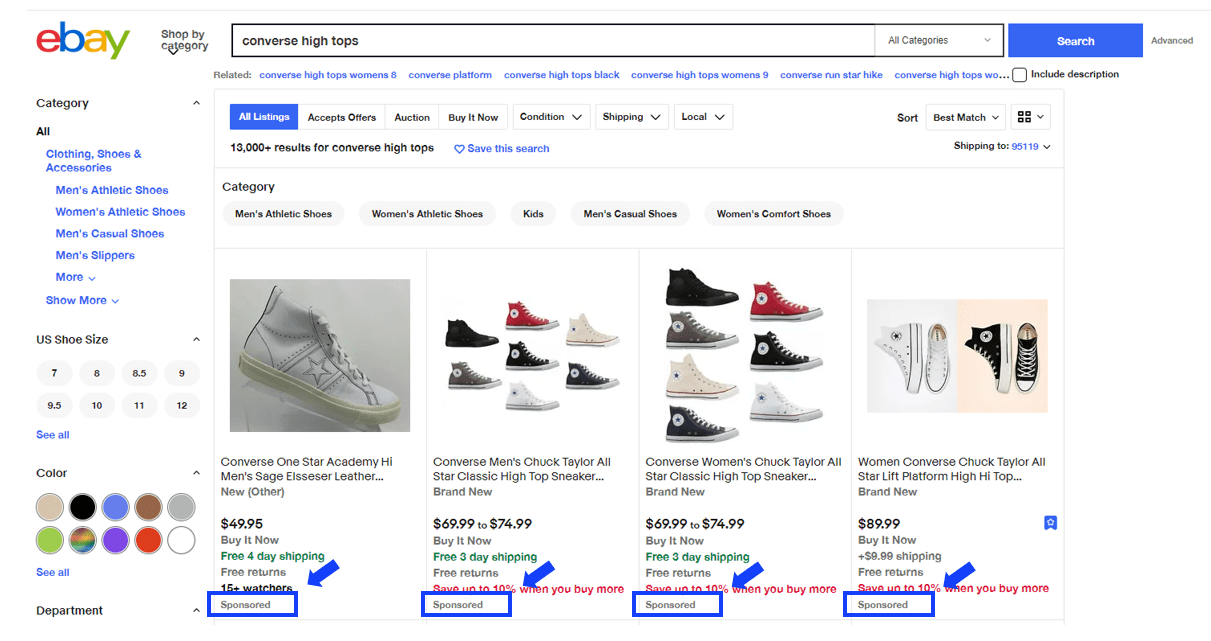
Who is eligible to use Promoted Listings Advanced?
Just like Standard and Express campaigns, you must have enough account activity and an above standard or top-rated seller level to utilize Advanced campaigns.
Additionally, if your listings meet the following criteria, they are not eligible for Advanced campaigns:
- Auction listings and auction listings with “Buy It Now”
- Products in these categories: wholesale & job lots, cars, motorcycles & vehicles, events tickets, property, e-cigarettes, vapes & accs, or “everything else”
- Listings that are out of stock
What are the fees for using Promoted Listings Advanced?
Advanced campaign fees are based on your keyword bid, your competitor’s bids, and the number of clicks your listings receive. However, your ad fees cannot exceed your daily budget for the campaign.
The actual amount per click you are charged is based on a second-price auction, meaning that the fee charged is calculated dynamically based on your listing quality, keyword relevance, bid, and bids made by your competition. For example, if your bid for the keyword “purple cowboy hat” is $3.00 and your competitor’s bid is $1.50, you win the auction, and the pay-per-click you would pay between $1.50 and $3.00.
Sales from Advanced campaigns are attributed within a 30-day window from the initial click of your Promoted Listing.
Learn how Feedonomics automates catalog listing on eBay.
Can you use Standard and Advanced campaigns to promote the same listings?
Yes, you can. It is important to keep in mind that with Advanced campaigns, you are only bidding for the top slots on eBay’s search results. Standard campaigns appear in other areas across eBay’s network. For full coverage, eBay recommends you use both campaign types in tandem.
Will my listing appear twice if I use Promoted Listings?
For any given search query, eBay’s algorithm determines whether your product’s organic listing, Standard listing, or Advanced listing appears higher in search results. eBay makes this determination based on a number of factors, including the quality of your listing, the ad rate, bid amount, and the product’s search relevancy. If you are using Promoted Listings to advertise ebay listings, only one of your listings—either promoted or non-promoted—displays in a given set of search results.
How can I track my Promoted Listings’ performance?
Sellers can access their Promoted Listings dashboard under the Performance tab of their Seller Hub. Here, sellers are able to see metrics for all of their Promoted Listings campaigns, including impressions, clicks, number sold, sales amount, ad fees, click-through rate, sales conversion rate, and the average sold ad rate.
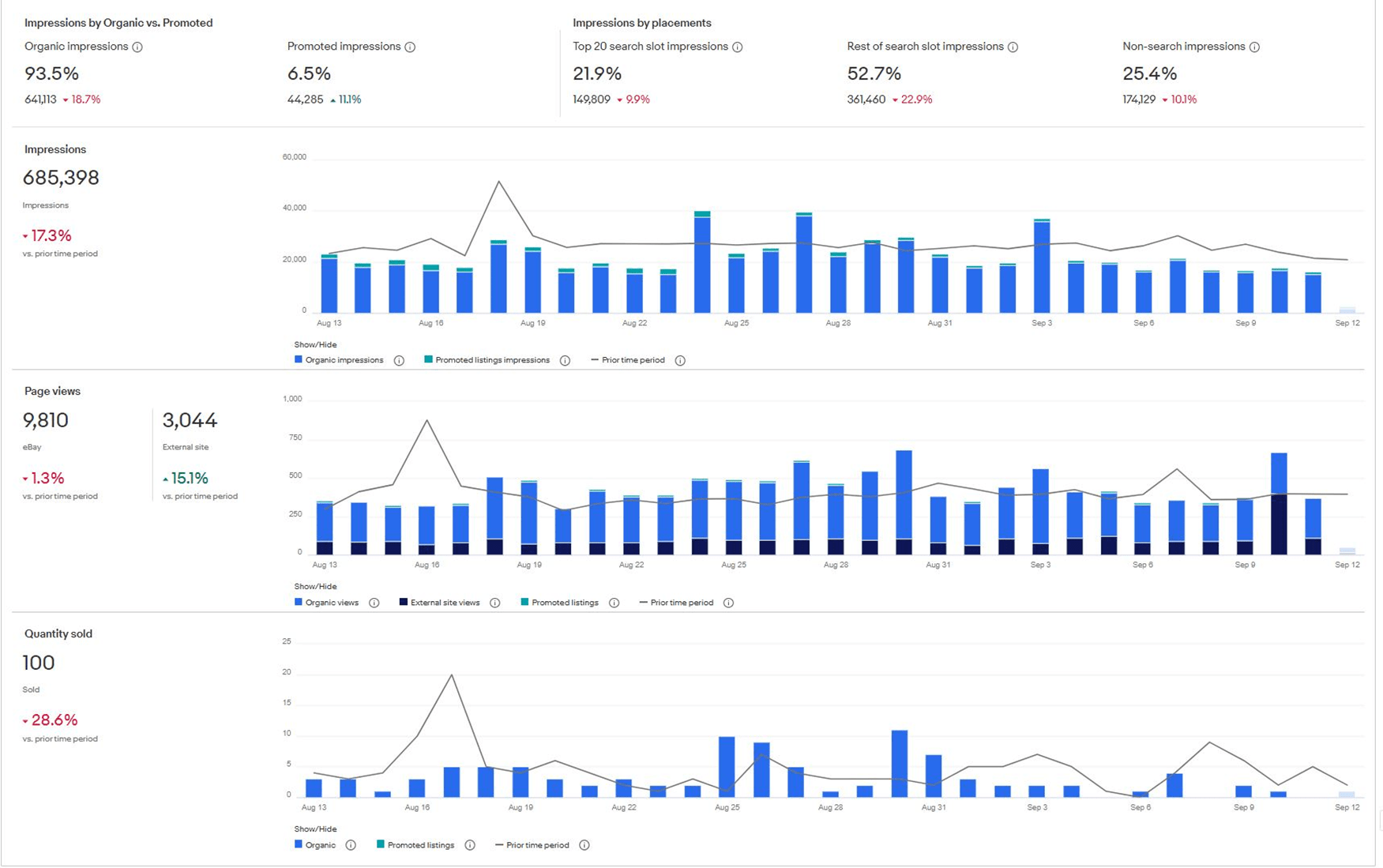
How can I tell if my listings are eligible for Promoted Listings?
You can see which of your products are eligible for Promoted Listings from your Seller Hub, on the marketing tab, or directly from the listings page. Filter your listings to see which products are eligible or already being promoted. The Promoted Listings column also shows you if a product is eligible to be promoted.

How do I set up a Promoted Listings campaign?
To get started on eBay and learn how to set up Promoted Listings, visit eBay’s tutorials for each campaign type and check out our eBay FAQs blog.
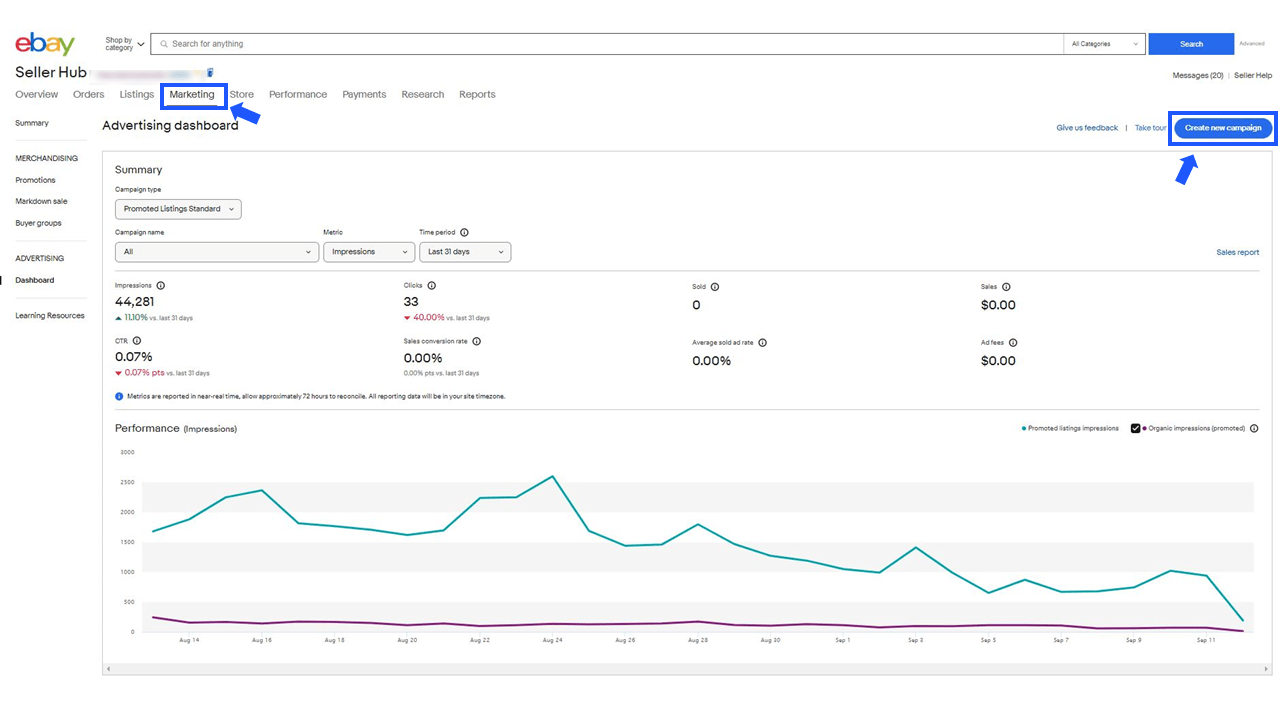
What are the benefits of using eBay Promoted Listings?
The key benefit of eBay’s Promoted Listing campaigns is the boost in product discoverability, which improves your chances of a sale. There is also a “halo” effect. If a user finds your sponsored listing, they are more likely to look at your other products as well. This organic exposure can lead to more sales for unsponsored listings. By using Promoted Listings Standard, Reebok was able to double its sales, while only paying 6% in ad fees.
When should I use Promoted Listings?
Depending on your industry, you may choose to use Promoted Listings all year, or get a boost during the holiday season and other peak sales times. It’s important to allow eBay to accumulate enough data to optimize its targeting and suggested ad rates. For example, sellers of school supplies would probably benefit most from starting a Promoted Listings campaign several weeks before peak selling season.
How can I get the most out of eBay Promoted Listings?
For the best performance, it is essential for sellers to adhere to eBay’s best practices for product listings and optimize their data to meet the criteria for the marketplace’s “Best Match.” Recommendations include creating complete and accurate listings, choosing the right selling format and category, and including high-quality images of your items. Prior to promoting a listing, a seller should ensure their product data meets or exceeds eBay’s suggestions.
The true key to Promoted Listings success lies in high-quality data, but optimizing your product data for hundreds or even thousands of eBay listings can be quite the load to bear. Our feed specialists are experts on eBay’s best practices and make data feed management easy. Book a demo today to learn how we can do the heavy lifting for you!

With its leading data feed management platform, Feedonomics helps brands, retailers, and agencies optimize and list products on hundreds of shopping destinations around the world. Learn more about our full-service solutions for advertising channels and marketplaces.

